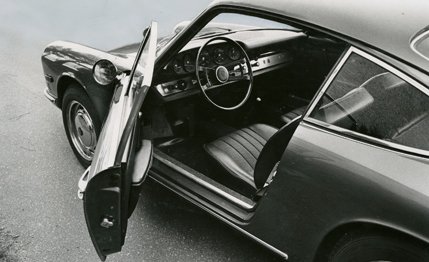In explaining how all this works, Porsche encourages you to engage D when and if you choose to move forward. Use L when ascending or descending steep grades. Cope with ice and ennui as best you can—a problem that Porsche has never had before.
D was dutifully selected and a moderate depression of the throttle opened all six Weber throttles in absolutely normal fashion. The result was a healthy roar from the engine compartment with a sadly disproportionate amount of forward progress. Any major throttle opening with the transmission in any of the D positions causes the tach to zoom up to about 3000 rpm and hang there until the car catches up. As a matter of fact, one of our biggest objections to the Sportomatic was trying to distinguish any one D from any other D. They all seemed the same. The engine sounded the same, the performance seemed about equal and we just didn’t know what to make of it.
Happily, once you get the thing over 3000 rpm, the system acts much more like a manual transmission. A little experimenting with the not-recommended L position resulted in an engine roar much more in keeping with the car’s speed and, better still, it reduced quarter-mile times by a half a second. Not bad. Don’t be alarmed, Porsche lovers, L is simply first gear in the manual transmission, so there is no reason why it shouldn’t be used for acceleration as well as braking.
One more moment of carping: you will remember we said that the clutch is automatically disengaged with even imperceptible movements of the shift lever. We weren’t kidding. The driver had better remember precisely where the shift lever is, because if he so much as rests his hand on it before he is ready to shift, the clutch will disengage and the tach will whirl out of sight before you can say “holy broken motor.” Porsche claims to have an automatic ignition cut-out, but who wants to see if it works?
|
|
With all this, it’s about time to make it clear that there’s absolutely no trouble in shifting. Just grab the lever and move it. No matter how fast you do it, it’s impossible to beat the clutch or the synchronizers. And that’s a real pay raise if you want a Porsche and your wife doesn’t because she doesn’t think she’ll be able to drive it. She will, and easily, too. And maybe that’s one of our objections. You may find yourself a little embarrassed when you’re trying to make a quick shift because the sound put out for the world to hear is a pretty strong implication that the driver doesn’t know when it’s safe to let the clutch out.
So you’re driving the Sportomatic with your hand poised, hawk-like, in mid-air, waiting the proper time to swoop down on the lever. But it might be well to remember that the hawk-like hand isn’t the only thing ever to hit that lever. You can do it with your knee under hard cornering—and who wants a Porsche if he isn’t going to bend it in a corner now and then—and if you go for the fast idle or heater controls located between the seats, and miss, you might find yourself in D3.
So we’re unhappy. And we’re unhappy because the 911 is still something of a standard for judging roadholding and ultimate cornering ability. We were pleasantly surprised to learn that those unfashionable 4.5-inch wide wheels used on Porsches almost since day one have been replaced by wheels an inch wider. Racing seems to have improved the breed here, and Porsche, which stormed off with the under 2-liter championship in the ‘67 Trans-Am series, has obviously paid attention to how they accomplished that. Ride harshness suffers, but what the hell, it‘s a Porsche, and Porsches are cars.
Porsche handling has usually generated debate among the oversteer-understeer factions. We like it, it’s got style and it works. Hang the tail out, put a wheel in the air and grab a handful of reverse lock, we say. On the other hand, we do recommend that a newcomer to the car approach it with great respect. The transition from initial understeer to mild oversteer can be disconcerting to the novice.
Another thing the 911 does well is stop. The truly sophisticated internally vented disc brakes on all four wheels pull the car down at a .91G deceleration rate in our 80 to 0 mph braking test. More than that, not a trace of fade was apparent after four stops. This kind of performance is vastly superior to what we’ve grown to expect from the more conventional disc front/drum rear systems on so many American and European cars.
View Photos
View Photos


Leave a Reply